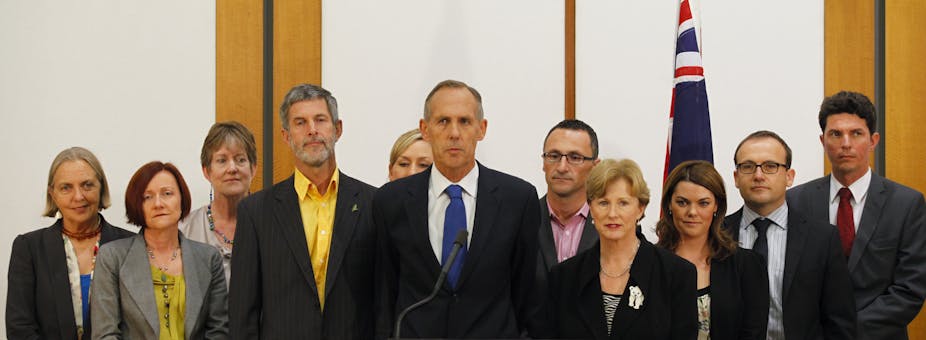The exit of Bob Brown raises an interesting issue for the Australian Greens. Now the party’s charismatic founder has gone, what will happen to the party? Does it have a long-term future, and if so, what kind of future?
There has long been a place in Australian politics for one minor party, that acts as a safety valve for those who are not happy with the state of politics. But that party does not have to be the Greens. If political circumstances change and another charismatic figure emerges a new party could well emerge to challenge the Greens for this role.
Three party politics
The Democrats became the first of these third parties in 1977. They had their heyday in the early years of the Howard government. For a time, it seemed possible that One Nation would also assume that role. But in past few years this role has been taken over by the Greens.
All of these parties were founded by a charismatic leader – Don Chipp for the Democrats and Pauline Hanson for One Nation – and came to be associated with that leader. This may partially explain why both the Democrats and One Nation are no longer significant political players.
All of these parties share an old-fashioned form of economic nationalism in which the state plays an important role. They have appealed to a particular constituency which feels that the two major parties are not really serving their interests, and that politics has failed them.
One could argue that what caused the emergence of third parties, and has sustained them, was Bob Hawke’s post-1983 economic reform, supported by both the major political parties, which sought to make Australia a more competitive and productive country.
Hence the desire, manifested in their economic nationalism, of minor parties to return to the “good old days”.
A limited appeal
The Greens are both the environmental party and the party of the big state and increased government control. This can be seen in many of their policies, for example their policies on education.
Their appeal is necessarily limited because the sort of constituency that they attract are those who do not like politics as practised by the major parties. They are the natural home for outsiders and ratbags. In this sense they are an “anti-political” political party.
This means that their appeal cannot rise much beyond 15% of the electorate. Hence they are very attractive to many young people who have problems with the major parties, and who do not yet feel that they are part of the political system. Green policies on education, that students should pay less and the state pay more, are attractive to this group. The Greens also appeal to academics who also feel somewhat alienated by the political system.
The end of the Greens?
One thing, I believe, is certain. The Greens will not become a major party unless they cease to be the Greens.
Major parties have to appeal to the broader Australian community and there is no indication that the Greens are capable of evolving in this way. What Bob Brown achieved was to make the Greens the unchallenged third player in Australian politics. It was a considerable achievement.
But they have now reached their peak. My feeling is that the best they can do is to maintain their level of support. However, the case of the Democrats may indicate that once the minor party in Australia peaks, the fact that it cannot go any further may be a sign of its ultimate decay.
Whatever the case there is no doubt that the Greens will miss Bob’s charisma.

